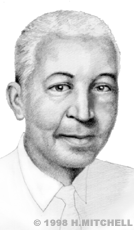Lloyd Hall
Like his coeval Frederick Jones, Lloyd Augustus Hall played a major role in the American food industry. While Jones revolutionized food transportation, Hall invented ways to preserve the foods themselves.
Born in Elgin, Illinois, Hall was a distinguished student. His BS in Pharmaceutical Chemistry from Northwestern University in Chicago (1916) paved the way for his ScD from Virginia State College (1944). In the interim, Hall became one of the nation's foremost food chemists.
In Chicago, Hall was the Senior Sanitary Chemist of the Department of Health and President of Chemical Products Corp., before joining Griffith Laboratories as a consultant in 1925. Here, while rising to the position of Technical Director and Chief Chemist, Hall earned over 100 U.S. and foreign patents in food chemistry.
Before Hall's inventions, the chemical preservation of foods was scarcely a science. Most preservation was done with salts, and it was difficult to keep foods from spoiling without making them taste bitter. Hall first found a way to use a combination of sodium chloride with tiny crystals of sodium nitrate and nitrite, which suppressed the nitrogen that spoiled the food (1932). This patented method of curing meats is still used today.
Hall next developed antioxidants, including lecithin, which stopped foods' fats and oils from spoiling by reacting with oxygen. Hall also discovered that some spices, like ginger and cloves, far from preserving foods, carry bacteria and molds that can actually speed up foods' spoiling. He later invented a system that used ethylene oxide gas in a vacuum chamber to purify foods of such microbes. That system was later adapted in order to sterilize prescription drugs and cosmetics.
Lloyd Augustus Hall's numerous innnovations benefited consumers as well as the food and drug industries. After retiring from Griffith in 1959, Hall served as a consultant to the Food and Agriculture Organization of the United Nations, where he shared his advances with developing countries. He worked for them until his death in 1971.


